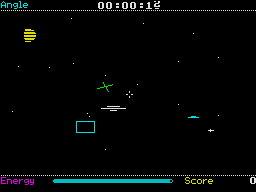
Space screen from Dark Star
Crystal has been noted for its sophisticated programs for well over a year and Halls of the Things has been one of the most enduringly popular Spectrum games. Now the company has been reborn under a new name with a fresh image and re-launches itself with an exciting new space game, DARK STAR. Programmers Graham Stafford and Simon Brattel came to visit us and explain themselves and how Crystal transformed into...
When Simon and Graham arrived at the CRASH offices on a sweltering day late in July, the relative peace was shattered. As Graham sat down and began to talk, Simon busied himself transforming the editorial office into a tangle of cables, interfaces, monitors and computers. The occasion was to show off their new game, Dark Star, and introduce us all to Basil (who, despite the name, is female). Basil is a software development computer built by Simon specifically for writing games for the Spectrum. Amidst the rattle of keyboards and sharp odour of soldering irons, Graham explained where Crystal came from and where Design Design is going to.
First of all I asked why they wanted to change the name from Crystal to Design Design. And why Design Design?
‘It conjures up the right image,’ says Graham. ‘We design programs rather than sitting around in some isolated tower writing them. But the word Design on its own, or Design Software doesn’t really sound right. The hard letter D at the front is good, but you should repeat it for effect, rather like Duran Duran — so Design Design.
‘The thing is, Crystal goes back a bit and the name is associated with Chris Clarke’s Crystal. Chris was one of the original founders before he moved on to Artic Computing. Now we want to alter the image. We want more contact with the magazines than we have had and we want to offer a more professional service across the board. We’d like the public to learn a lot more about us, because we like to think we’re unique in various ways.’ Graham points to the conglomeration of boards, connectors and chips that make up the emerging Basil. ‘You’ll see why in a minute,’ he grins.
I ask him whether they are altering the name and image now because it’s the low summer period and Simon looks up from his soldering to say that they release games when they are ready and not because of the time of year. But Graham adds:
‘Well we have wanted to change the name before this. Last Christmas we did very well and we said, let’s sit back, let’s invest money in equipment, let’s invest money in finding people to work. Let’s do what we feel we’ve always wanted to do but never had the funds to do it. Because, you see, we all started from university as a bunch of guys who thought, look at this software that’s being produced, we can walk all over it, and that’s how we got together. The company is by no means what it originally was.
‘Chris Clarke was the originator of Crystal. I was his partner. After a while, for various reasons, Chris left. Invasion of the Body Snatchas was about to come out. I wanted to change the name then, but a new software company coming out at Christmas is not a good idea. So we thought we’ll continue on with the old name and then halfway through next year, we’ll plan it all properly, we’ll come out with some very special programs and let everybody know about it. I know there are programs of ours that haven’t been received very well, although happily that’s a rare occurrence, and we would like to think that by Christmas this year we will be more of a force than we are now.’
The software house we know as Crystal originated from Manchester University — specifically from two rooms in Owens Park Hall of Residence. Graham looked after the stock and the programming while Chris Clarke looked after all the administration. As the operation expanded, more programmers came to join them. The Manchester-based re-born Design Design now consists of a main core of four, Graham, Simon, Neil Mottershead and David Llwellyn. David is the company’s administrator while Graham programs mainly on the Commodore 64. Simon and Neil work on the Spectrum and used to program as a partnership.

Space screen from Dark Star
‘They now program separately,’ says Graham. ‘Not because they didn’t program well together, because the results show that they did (Halls of the Things and Warlock of Firetop Mountain), but they wanted to pursue different avenues in games. Most of the games so far have been more in Simon’s vein than Neil’s.’
Design Design operates from a large terraced house near Manchester which, for reasons of security, they would prefer to remain anonymous.
‘Three of the four of us live and work in this house. Neil used to as well, but now lives with his parents in Stockport. In all there are six people and an office there. We program in our bedrooms — the rooms are quite large — we get up when we want — we program when we want — we go to the pub when we want. It’s not a 9 to 5 job because we’ve found you can program a lot better like that. You can program at night when there’s no noise if you want.’
Simon glances up, Basil is almost ready. ‘In fact most programmers seem to work at night,’ he adds.
We laugh about Imagine’s PR type ads where the programmers of the megagames are shown living off Coke and junk food. ‘Well that’s true,’ says Graham. ‘Programmers do need something. I need to smoke. Simon drinks Coke at horrific rates. Jon Ritman drinks coffee, thick, black tar! It’s anything that requires mind concentration you see.’
How do the Design Design team go about writing programs?
‘Most times it starts off as trying to prove a point, like with Dark Star,’ Simon goes on ‘I thought you could do 3D graphics at speed and no one else did. When it’s going we get all the people in the house, because it’s almost a commune, and any of our friends, and we play about with the coding — what if we change the speed of the aliens, etc.? And when that’s done we don’t go and play with it again until a couple of weeks or so, and then you do it all again. Eventually you end up with a program that’s had a lot of ideas and different versions tried. Then I take it down to my brother, who’s a school teacher. They’ve got 60 pupils with Spectrums and we give him a copy and say right, pirate that! I come back in a couple of weeks and go in and see them playing and that’s where I get my feedback from.’
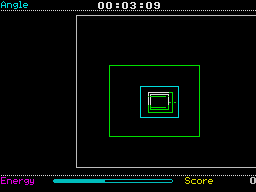
Hyperspace tunnel from Dark Star
Graham takes up the point about programmers. ‘We think the programmer is important — people like a Simon Brattel program — they go and buy a Simon Brattel game — it’s not the company they’re buying. There’s an awful lot of companies out there that are the Company Image. Just because it’s Imagine, doesn’t mean it’s a good game.’
There’s also the advantage of pushing the programmer instead of the company image, that when a game fails to excite the buyer, it doesn’t necessarily put people off the company, I point out.
‘Well, It’s the Wooluf!, for example, did not get well received,’ Graham starts.
‘It’s my fault,’ Simon interjects. ‘Because I looked at it and said, ah, it’s a sprite game. People like sprite games, let’s sell it. It was a well written sprite game, but it’s like a blind spot because we don’t like sprite games so I couldn’t see that it wasn’t going to be received well.’
‘Now we don’t want that to impair the chances of, say, Dark Star, because it isn’t the same person who wrote them both,’ Graham adds. ‘His next game (Martin Buller — It’s the Wooluf!) is very good though — excellent. It’s one of those car driving games like Atari’s Pole Position. He’s done it almost as well as the arcade. I’m really staggered because I’d written it off as one you couldn’t do.’
A clatter from Simon’s long, customised keyboard announced that Basil is up and ready with a new game loaded from disc. But before we gather eagerly around the screen for the preview, Graham and Simon explain the equipment they have brought with them.
‘As you notice,’ Graham starts, ‘we don’t trust anyone else’s hardware. We looked around for something to write software, but gave up. We’re both originally electronic engineers so we did it ourselves. Simon’s built all of his computers — he’s never bought a commercial computer.’
‘I did buy a Beeb,’ Simon adds quietly. At this point he rummages about in an amazingly battered brown suitcase which ‘saw his mother through the war,’ and produces a long PCB strapped between aluminium frames and introduces us to The Beast. The Beast is the development system designed by Simon and on which Halls and Firetop were written. ‘It became unreliable after a bit, so I designed Basil,’ he says.
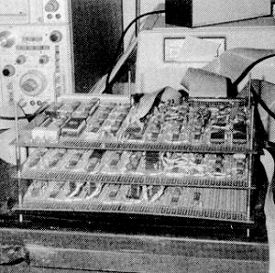
Basil
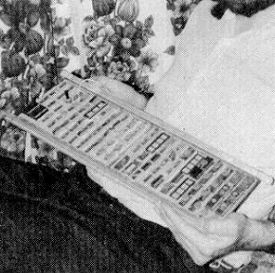
The Beast
Graham takes up the story. ‘Now Basil’s got half a megabyte of RAM, the Z80 processor runs at 7 meg and the discs have got hundreds and hundreds of Ks flying around. It is specifically designed and devoted to writing software for the ZX Spectrum. We’ve got the Zeus Assembler in there, all written by ourselves, the whole operating system and everything in there is tailor-made for writing software for the Spectrum. No one else we know has done that and that is one reason why we consider ourselves unique, in that we do all our own hardware for writing the programs. We don’t go out and spend £7,000 on Sages like Imagine did when they were still alive — it didn’t get them very far. You’re wasting your money. Basil cost about £500 not including the discs. Imagine had 20 Sages and had placed an order for 34 more!’ He looks scandalised at us.
‘The one thing about Sage,’ says Simon, ‘is that for writing Z80 programs, Basil outperforms it by about 5 to 1 for speed because it’s designed to.’
‘So we’ve got the hardware side,’ Graham continues. ‘You can appreciate the hardware and how it works. You know that when you’re doing a certain instruction that’s how many T-states it takes and you know that’s why it takes so many T-states. You can write more efficient and faster codes.
‘So, as you can see, we’re not a group of people who brought the ZX81 and learnt programming like that. We’ve got a very solid background in all aspects of computing. If you can build your own computers then you know how they work, you know how to pull the best out of them, you know how to really stretch them to the limits.’
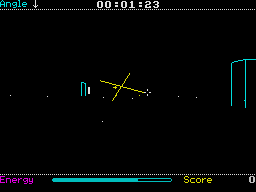
Planet screen from Dark Star
By this time CRASH reviewer Matthew Uffindell is anxiously hovering around the, as yet, blank screen of the colour monitor, awaiting a glimpse of Dark Star. But Simon has the game firmly bottled up inside Basil. ‘Before we look at anything,’ he says sternly, ‘there’s something I want to chat about, because I don’t like the way you review games at all. This Use of colour, Use of sound — I mean, let’s suppose Mike Oldfield, say, comes out with a new record; can you imagine any reviewer who said use of bass guitar, use of keyboard, would get very far?’
I tell him that I agree.
‘Can you say that in the article?’ he demands.
I agree to that as well and try to explain that when CRASH was first conceived I didn’t want to have ratings, hoping that the reviews would stand on their own. But everyone else concerned with the project felt that magazine reviews had to have ratings.
Graham joins in. ‘A case in point. On Invasion of the Body Snatchas we felt the actual review, what they said about the game, was very fair —’
‘What they said about the game in the critical comments,’ Simon interjects, ‘was spot on. It has to be because it’s someone’s opinion.’
‘But the ratings were wrong,’ Graham says. ‘It got 67% (69½% in fact) and they said this is a very nice version of Defender for the Spectrum, shame about the lack of sound. And then there were programs in the same issue that they said, this is absolute garbage but it’s got nice graphics, as in ‘big blobs moving around’. And it was getting the same overall mark. So we felt unfairly done to because if someone had read the two reviews they would have felt that Invasion was a far superior program to the other one, BUT if they just looked at the ratings (which an awful lot of people will do) and then read the review if it looks like a good rating, then they would get totally the wrong idea.’
We go on to talk about the ethics of reviews in general and Graham points out that they differ with CRASH in several respects where games we think are good, they think are not. But clearly the game that has most annoyed them recently is Psytron. ‘It really got up our wick,’ Graham says indignantly. ‘Not because it’s selling well but because they get up and say that that program makes other programmers gasp! And it doesn’t!’
‘If you’re not an honest programmer you’re not going to write an honest game,’ Simon adds. ‘We know a lot of programmers in the industry and you find that programmers have a very different opinion of their games to the market.’
So how does he feel about his games?
‘Halls of the Things is our game. It’s leaps and bounds above anything we’ve ever done. That’s an honest opinion. It’s not my program because three of us wrote it. I don’t necessarily like my own programs just because I wrote them. That would be stupid because if you had that attitude you would accept any old garbage. Programmers can’t have that attitude. I hate Invasion of the Body Snatchas. I don’t like the game. Rommel’s Revenge was a disaster. I don’t know why people like playing it because it’s too slow.’
What about the reviewers’ accusation that Invasion lacked sound?
‘There’s this class of games which are very predictable. A case in point — I’m not insulting it — is Manic Miner. Matthew Smith knows exactly how long it’s going to take to do each frame of display because he’ll save on the monsters, they’re always about the same size and speed, so he can make noises because he can interleave the highs and lows as it is predictable. In Invasion you can’t do that because there’s a random number of monsters, there’s a random number of projectiles, the landscape changes, all the times vary so you can’t get up and actually make a proper noise. What you have got to do is stop the game, make the noise, and carry on. Of the other versions, Defenda (Interstella) is silent — they’ve seen the problem, Starblitz (Softek) makes noises and you can see it jerk. This is why we didn’t put sound on the screen.’
So, if Simon dislikes Invasion so much, why do it in the first place?
‘I did it to prove a point. A friend of mine and I were playing Beeb Defenda and he said you couldn’t do a Defender on the Spectrum anything like as successfully as Acorn Soft’s. I got up and said you could and spent the next two months regretting it! And that’s also what happened on Dark Star. The same friend said you couldn’t begin to do proper 3D graphics at high speed on the Spectrum. I thought, right! I hate 3D games, they’re all dreadful, they’re slow, none of them do the stars properly, they’re all terrible games, they all look hacked. Let’s get up and do something about it. So Dark Star was developed from someone saying you couldn’t do it properly.’
By now everyone is watering at the mouth. When will the amazing Dark Star be revealed? Not yet it seems...
Talking about releasing games naturally leads to discussion of piracy. Design Design seem to take a very philosophical view of it all. Says Graham, ‘We wouldn’t go and sue a kid for copying our program. We’d have a go at any company that does it. Someone did it with Rommel’s and we’re in the process there. Luckily though, none of our games have been a Sabre Wulf or an Atic Atac such that if they run off a thousand illegal copies and dump them on the market nobody’s going to notice those extra thousand and they’re definitely going to sell because it’s only been out four days. Ours seem to sell steadily for a long while. It’s incredible how Halls still sells.’

Simon
So how many programmers are there working at or with Design Design? Graham isn’t specific, apart from the actual members there are a number of others who market through them and the four men in the team are in contact with other well known programmers who contribute to the spirit of Design Design but go their own way in marketing, like John Ritman (Bear Bovver).
‘Well on the Spectrum front we’ve got a lot of good programmers,’ says Graham. ‘We’ve also got a good Dragon 32 programmer. Some our Spectrum programmers will be time-spliced to do work on the Amstrad because the Amstrad is a nice machine. You can forget MSX!’
Simon, who has been sitting at his keyboard playing Space Invaders to keep Matthew Uffindell on a keener edge for the revealing of Dark Star, suddenly leaps animatedly to his feet. ‘Can we put a point across about MSX?’ We all look up expectantly. MSX has been on everyone’s mind recently.
Simon walks to the window and turns around. ‘MSX is a terrible standard. It is terrible,’ he repeats emphatically. ‘I’m speaking as a designer. That’s why I was stressing I can design computers. Because no one’s gone on about the hardware on the MSX. It’s got a sprite chip. There are going to be a lot of companies in the market who write sprite type games who will love that computer.’
Graham joins in. ‘Ocean, although they’re not too keen on the MSX, think it’s reasonably good and they prefer it to the Amstrad. And the reason is because on the Amstrad you’ve got a raster display like on the Spectrum. You can do whatever you want with it. BUT you’ve got to think about it and write software to drive it. On the MSX you just do this pretty shape and shove something out of a port.’
Simon taps the edge of the desk firmly. ‘Let’s get this straight. Sprites are fine, I’m not anti-sprite. But you cannot have ONLY sprites, and that’s more or less what MSX has done. Because you can’t get at the video display memory. I’m seriously opposed to MSX. People are going to fall left, right and centre for MSX because it suits their sprite games. But in six months time, when everybody’s tired of sprite games, there’s going to be no alternative. The software industry will go poomph!
‘On top of that,’ he continues agitatedly, ‘I don’t think a standard is good for the software industry. At the moment there are lots of software houses who eke out a living because they are very good in one particular niche. If you’ve got a standard for machines so you can write one game for all computers on the market — supposing this horrid situation should ever arise — then the software houses who are best at sprite games are going to crush everyone else. It’s not good for the British computer industry to throw it all away to some Japanese standard that isn’t really a proper standard anyway.
‘Another point is, it is claimed, that MSX has good graphics. I’d just like to reinforce this point — graphics doesn’t just mean pretty shapes. Dark Star does not have pretty shapes — the reason it’s got good graphics is because it moves fast. Graphics should be interactive. Now the thing about MSX is that the update on display is so slow that you can’t do vector graphics so you won’t be able to do 3D games like Dark Star, Rommel’s Revenge or Combat Zone. I’ve seen some of the MSX games from Japan and a lot of people looking at them say, oh they’re garbage but they’ll get better because the Spectrum games got better. But it WON’T get better! Because MSX isn’t an open-ended system. Spectrum games were awful when they first came out because they programmers didn’t know what they were doing. But because the display is versatile you can get to do better and better things with the machine. The Spectrum encourages you to write different programs for it. And a programmer can’t ask for more than a good processor like the Z80 running fast, a reasonable amount of memory, which the Spectrum’s got, and a display which is easy to get to.’
We make the analogy that the musical equivalent of MSX in the music recording industry would force musicians to write in only a very specific way, limiting music to a single type. Simon points out that the Spectrum, which isn’t a sprite machine nevertheless has probably the best sprite games written for it, like the Ultimate games.
Well what about the QL then? There’s a moment of silence and they both laugh. ‘Hah! Forget it, it’s terrible, it’s already failed. We knew it would,’ says Graham.

Graham
Finally, the moment arrives. Simon is clacking away noisily on his extraordinarily long, custom keyboard, calling up bits of Dark Star from disc and dumping it into the Spectrum. As the first sheet appears, deep space, spinning plasma bolts, alien ships, an amazing star field moving in perfect 3D, we gasp at the sheer speed of the graphics. No one has seen such fast or smooth animation. ‘Star Wars’ someone mutters, recalling the great arcade favourite of recent months.
‘I don’t mind the association with Star Wars,’ Simon says as he deftly keys himself between two zooming tower blocks (he hates joysticks). ‘The thing is, though, that we thought of it before Star Wars and it does look like Star Wars. It was an original game and fate **** on us!’
Each Crystal game has incorporated some sort of innovation like the loading routine which gets rid of the flashing border, like the proportional spacing used in Hi-score sheets — Dark Star’s innovation is its amazingly flexible front end which incorporates, for the first time ever on the Spectrum, truly user definable keys. And they mean KEYS because on Dark Star you can define any key (except the top row) to a function, you can have as many keys as you like to control a function and indeed you can have the same key controlling two or even three functions. This means, for instance, that it is possible to select accelerate and fire at the same time if you wish, or keys to make your ship accelerate and dive whilst banking to the left — and so on.
There are three sheets on Dark Star although the game is still in its unlinked pieces, and it may be that more detail will be added before its planned release. There is a space sheet where you are attacked by alien saucers firing plasma bolts and you can fire back. You can also enter hyperspace fields which take you into the second sheet, a startling 3D warp tunnel which weaves all over space. This more resembles a road race game, because you can fly out of the tunnel and see it weaving through space below or to the side of you, but the longer you are out of its enclosing protection, the more damage you sustain. The third screen takes place down on the planet surface, the stars now forming the lights of a huge city. Tower blocks rise into the night sky, some of them friendly, some alien and firing at you.
Behind all this action, there lies a strategic plot about rescuing princesses from towers, accomplished by battling the enemy for planets to gain supreme control. If it all seems too difficult, Simon has designed the front end to allow the player to completely customise the entire game to suit players’ skills and growing abilities.
And what about the sound? Simon gives a short laugh. ‘I will try and do noises on Dark Star. But it’s basically that if you put noises in you slow down the game. So what we shall do is hack things into the divide routine. In between sheets we’ll do something.’
As the others get to grips with Dark Star, Graham tells me about Design Design’s other new games. They’re releasing Halls of the Things for the Commodore soon, there’s another space game provisionally nicknamed The Spinning Around Game which is for the Spectrum. Martin Buller, who wrote It’s the Wooluf! is at work on a racing game and the team are at work on the sequel to Halls, Return of the Things, which should be ready for Christmas. ‘If you think the monsters were mean in Halls, wait until you see them in Return!’ Graham says enthusiastically.
After some four and a half hours, Graham and Simon pack away all the equipment. Basil is returned to her battered suitcase, the one that saw mother through the war, and the two programmers head north for Manchester. We plan to make arrangements for a photographer to visit them next week to get pictures of everyone and then peace settles once again on Ludlow.
ROGER KEAN